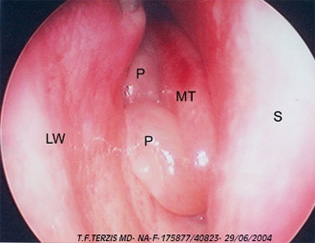Chronic Rhinosinusitis and Nasal Polyps

Chronic Inflammation in the nose and the sinuses, which surround it, is called chronic rhinosinusitis and affects more than 12% of the population. Nasal blockage, thick discharge, pain in the forehead or around the eyes are the usual symptoms, which often do not respond to medical treatment and need surgical intervention.
Possible causes contributing to the development and persistence of chronic rhinosinusitis are various, including allergy, infection due to either bacteria or fungi, and mechanical obstruction.
Individuals with the relevant genetic predisposition, can develop soft swellings inside the nose, which are called polyps. Nasal polyps are not tumours. They are simply multi-focal local enlargement of the lining of the nose, which hangs down and produce a characteristic soft appearance (Figure N10), which resembles to pressed grapes. Polyps disturb nasal breathing and often obstruct the openings of the sinuses, predisposing to infections. Chronic Rhinosinusistis can co-exist with lung problems, such as asthma.
Treatment of Chronic Rhinosinusistis is initially medical, based on anti-inflammatory drugs, especially steroids. The commonest drug prescribed for rhinosinusitis is cortizone spray. Most cortizone sprays in the market work locally; they are not absorbed by the mucosa, and therefore are safe for long-term use. In persisting cases, treatment schemes of steroids delivered by mouth or intramuscularly may be appropriate. Antibiotics or antimycotics are used in the presence of infection. If Allergy to inhaled allergens has been shown by relevant investigations, desensitization may be indicated. When asthma or other lung conditions are present, consultation with a Chest physician and appropriate treatment and follow-up are mandatory.
In spite of all these therapeutic measures, there are patients who fail to respond satisfactorily and continue to suffer troublesome symptoms, which significantly affect their quality of life. These patients are candidates for surgical treatment, which nowadays is done by the endoscopic approach.